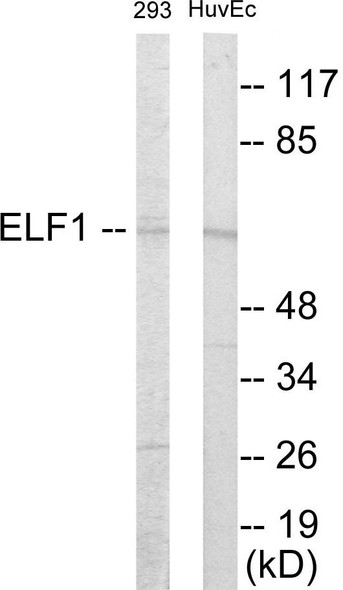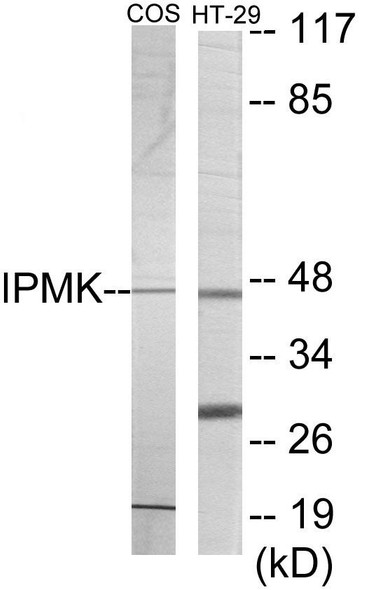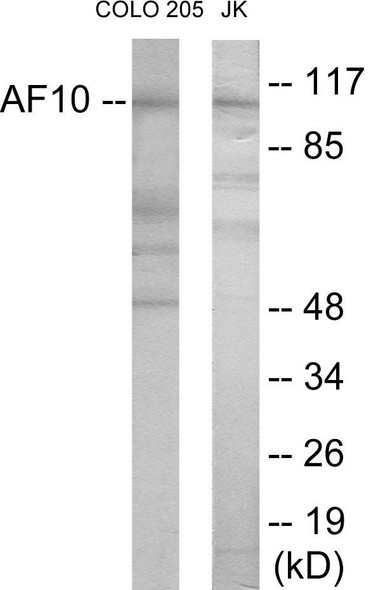Epigenetics and Nuclear Signaling
NCBP2 Colorimetric Cell-Based ELISA
- SKU:
- CBCAB01030
- Product Type:
- ELISA Kit
- ELISA Type:
- Cell Based
- Research Area:
- Epigenetics and Nuclear Signaling
- Reactivity:
- Human
- Reactivity:
- Mouse
- Detection Method:
- Colorimetric
Description
| Product Name: | NCBP2 Colorimetric Cell-Based ELISA |
| Product Code: | CBCAB01030 |
| ELISA Type: | Cell-Based |
| Target: | NCBP2 |
| Reactivity: | Human, Mouse |
| Dynamic Range: | > 5000 Cells |
| Detection Method: | Colorimetric 450 nmStorage/Stability:4°C/6 Months |
| Format: | 96-Well Microplate |
The NCBP2 Colorimetric Cell-Based ELISA Kit is a convenient, lysate-free, high throughput and sensitive assay kit that can detect NCBP2 protein expression profile in cells. The kit can be used for measuring the relative amounts of NCBP2 in cultured cells as well as screening for the effects that various treatments, inhibitors (ie siRNA or chemicals), or activators have on NCBP2.
Qualitative determination of NCBP2 concentration is achieved by an indirect ELISA format. In essence, NCBP2 is captured by NCBP2-specific primary antibodies while the HRP-conjugated secondary antibodies bind the Fc region of the primary antibody. Through this binding, the HRP enzyme conjugated to the secondary antibody can catalyze a colorimetric reaction upon substrate addition. Due to the qualitative nature of the Cell-Based ELISA, multiple normalization methods are needed:
| 1. | A monoclonal antibody specific for human GAPDH is included to serve as an internal positive control in normalizing the target absorbance values. |
| 2. | Following the colorimetric measurement of HRP activity via substrate addition, the Crystal Violet whole-cell staining method may be used to determine cell density. After staining, the results can be analysed by normalizing the absorbance values to cell amounts, by which the plating difference can be adjusted. |
| Database Information: | Gene ID: 22916, UniProt ID: P52298, OMIM: 605133, Unigene: Hs.591671 |
| Gene Symbol: | NCBP2 |
| Sub Type: | None |
| UniProt Protein Function: | NCBP2: Component of the cap-binding complex (CBC), which binds co-transcriptionally to the 5' cap of pre-mRNAs and is involved in various processes such as pre-mRNA splicing, translation regulation, nonsense-mediated mRNA decay, RNA-mediated gene silencing (RNAi) by microRNAs (miRNAs) and mRNA export. The CBC complex is involved in mRNA export from the nucleus via its interaction with ALYREF/THOC4/ALY, leading to the recruitment of the mRNA export machinery to the 5' end of mRNA and to mRNA export in a 5' to 3' direction through the nuclear pore. The CBC complex is also involved in mediating U snRNA and intronless mRNAs export from the nucleus. The CBC complex is essential for a pioneer round of mRNA translation, before steady state translation when the CBC complex is replaced by cytoplasmic cap-binding protein eIF4E. The pioneer round of mRNA translation mediated by the CBC complex plays a central role in nonsense-mediated mRNA decay (NMD), NMD only taking place in mRNAs bound to the CBC complex, but not on eIF4E-bound mRNAs. The CBC complex enhances NMD in mRNAs containing at least one exon-junction complex (EJC) via its interaction with UPF1, promoting the interaction between UPF1 and UPF2. The CBC complex is also involved in 'failsafe' NMD, which is independent of the EJC complex, while it does not participate in Staufen-mediated mRNA decay (SMD). During cell proliferation, the CBC complex is also involved in microRNAs (miRNAs) biogenesis via its interaction with SRRT/ARS2, thereby being required for miRNA- mediated RNA interference. The CBC complex also acts as a negative regulator of PARN, thereby acting as an inhibitor of mRNA deadenylation. In the CBC complex, NCBP2/CBP20 recognizes and binds capped RNAs (m7GpppG-capped RNA) but requires NCBP1/CBP80 to stabilize the movement of its N-terminal loop and lock the CBC into a high affinity cap-binding state with the cap structure. Belongs to the RRM NCBP2 family. 2 isoforms of the human protein are produced by alternative splicing. |
| UniProt Protein Details: | Protein type:Translation; RNA-binding; Spliceosome; RNA splicing Chromosomal Location of Human Ortholog: 3q29 Cellular Component: cytoplasm; cytosol; mRNA cap complex; nucleoplasm; nucleus Molecular Function:mRNA binding; nucleotide binding; protein binding; RNA 7-methylguanosine cap binding; RNA binding; RNA cap binding; snRNA binding Biological Process: gene expression; histone mRNA metabolic process; mRNA 3'-end processing; mRNA capping; mRNA catabolic process, nonsense-mediated decay; mRNA export from nucleus; nuclear mRNA cis splicing, via U2-type spliceosome; nuclear mRNA splicing, via spliceosome; positive regulation of mRNA 3'-end processing; positive regulation of RNA export from nucleus; positive regulation of viral transcription; regulation of translational initiation; RNA elongation from RNA polymerase II promoter; RNA splicing; RNA-mediated gene silencing; snRNA export from nucleus; spliceosomal snRNP biogenesis; termination of RNA polymerase II transcription; transcription from RNA polymerase II promoter; viral reproduction |
| NCBI Summary: | The product of this gene is a component of the nuclear cap-binding protein complex (CBC), which binds to the monomethylated 5' cap of nascent pre-mRNA in the nucleoplasm. The encoded protein has an RNP domain commonly found in RNA binding proteins, and contains the cap-binding activity. The CBC promotes pre-mRNA splicing, 3'-end processing, RNA nuclear export, and nonsense-mediated mRNA decay. Multiple transcript variants encoding different isoforms have been found for this gene. [provided by RefSeq, Jul 2008] |
| UniProt Code: | P52298 |
| NCBI GenInfo Identifier: | 1705651 |
| NCBI Gene ID: | 22916 |
| NCBI Accession: | P52298.1 |
| UniProt Secondary Accession: | P52298,Q14924, Q2TS50, B2RE91, B4DMK7, E9PAR5, |
| UniProt Related Accession: | P52298 |
| Molecular Weight: | 11,932 Da |
| NCBI Full Name: | Nuclear cap-binding protein subunit 2 |
| NCBI Synonym Full Names: | nuclear cap binding protein subunit 2 |
| NCBI Official Symbol: | NCBP2 |
| NCBI Official Synonym Symbols: | CBC2; NIP1; CBP20; PIG55 |
| NCBI Protein Information: | nuclear cap-binding protein subunit 2 |
| UniProt Protein Name: | Nuclear cap-binding protein subunit 2 |
| UniProt Synonym Protein Names: | 20 kDa nuclear cap-binding protein; Cell proliferation-inducing gene 55 protein; NCBP 20 kDa subunit; CBP20; NCBP-interacting protein 1; NIP1 |
| Protein Family: | Nuclear cap-binding protein |
| UniProt Gene Name: | NCBP2 |
| UniProt Entry Name: | NCBP2_HUMAN |
| Component | Quantity |
| 96-Well Cell Culture Clear-Bottom Microplate | 2 plates |
| 10X TBS | 24 mL |
| Quenching Buffer | 24 mL |
| Blocking Buffer | 50 mL |
| 15X Wash Buffer | 50 mL |
| Primary Antibody Diluent | 12 mL |
| 100x Anti-Phospho Target Antibody | 60 µL |
| 100x Anti-Target Antibody | 60 µL |
| Anti-GAPDH Antibody | 60 µL |
| HRP-Conjugated Anti-Rabbit IgG Antibody | 12 mL |
| HRP-Conjugated Anti-Mouse IgG Antibody | 12 mL |
| SDS Solution | 12 mL |
| Stop Solution | 24 mL |
| Ready-to-Use Substrate | 12 mL |
| Crystal Violet Solution | 12 mL |
| Adhesive Plate Seals | 2 seals |
The following materials and/or equipment are NOT provided in this kit but are necessary to successfully conduct the experiment:
- Microplate reader able to measure absorbance at 450 nm and/or 595 nm for Crystal Violet Cell Staining (Optional)
- Micropipettes with capability of measuring volumes ranging from 1 µL to 1 ml
- 37% formaldehyde (Sigma Cat# F-8775) or formaldehyde from other sources
- Squirt bottle, manifold dispenser, multichannel pipette reservoir or automated microplate washer
- Graph paper or computer software capable of generating or displaying logarithmic functions
- Absorbent papers or vacuum aspirator
- Test tubes or microfuge tubes capable of storing ≥1 ml
- Poly-L-Lysine (Sigma Cat# P4832 for suspension cells)
- Orbital shaker (optional)
- Deionized or sterile water
*Note: Protocols are specific to each batch/lot. For the correct instructions please follow the protocol included in your kit.
| Step | Procedure |
| 1. | Seed 200 µL of 20,000 adherent cells in culture medium in each well of a 96-well plate. The plates included in the kit are sterile and treated for cell culture. For suspension cells and loosely attached cells, coat the plates with 100 µL of 10 µg/ml Poly-L-Lysine (not included) to each well of a 96-well plate for 30 minutes at 37°C prior to adding cells. |
| 2. | Incubate the cells for overnight at 37°C, 5% CO2. |
| 3. | Treat the cells as desired. |
| 4. | Remove the cell culture medium and rinse with 200 µL of 1x TBS, twice. |
| 5. | Fix the cells by incubating with 100 µL of Fixing Solution for 20 minutes at room temperature. The 4% formaldehyde is used for adherent cells and 8% formaldehyde is used for suspension cells and loosely attached cells. |
| 6. | Remove the Fixing Solution and wash the plate 3 times with 200 µL 1x Wash Buffer for five minutes each time with gentle shaking on the orbital shaker. The plate can be stored at 4°C for a week. |
| 7. | Add 100 µL of Quenching Buffer and incubate for 20 minutes at room temperature. |
| 8. | Wash the plate 3 times with 1x Wash Buffer for 5 minutes each time. |
| 9. | Add 200 µL of Blocking Buffer and incubate for 1 hour at room temperature. |
| 10. | Wash 3 times with 200 µL of 1x Wash Buffer for 5 minutes each time. |
| 11. | Add 50 µL of 1x primary antibodies (Anti-NCBP2 Antibody and/or Anti-GAPDH Antibody) to the corresponding wells, cover with Parafilm and incubate for 16 hours (overnight) at 4°C. If the target expression is known to be high, incubate for 2 hours at room temperature. |
| 12. | Wash 3 times with 200 µL of 1x Wash Buffer for 5 minutes each time. |
| 13. | Add 50 µL of 1x secondary antibodies (HRP-Conjugated AntiRabbit IgG Antibody or HRP-Conjugated Anti-Mouse IgG Antibody) to corresponding wells and incubate for 1.5 hours at room temperature. |
| 14. | Wash 3 times with 200 µL of 1x Wash Buffer for 5 minutes each time. |
| 15. | Add 50 µL of Ready-to-Use Substrate to each well and incubate for 30 minutes at room temperature in the dark. |
| 16. | Add 50 µL of Stop Solution to each well and read OD at 450 nm immediately using the microplate reader. |
(Additional Crystal Violet staining may be performed if desired – details of this may be found in the kit technical manual.)






